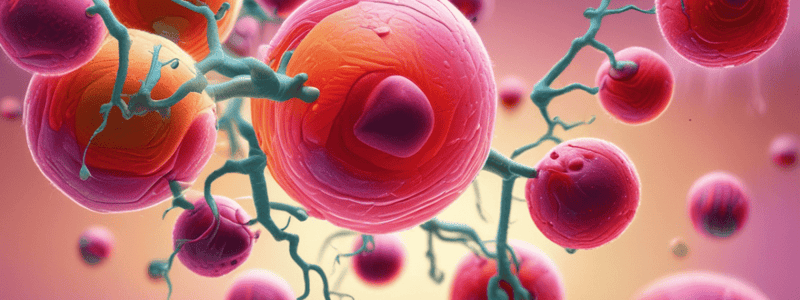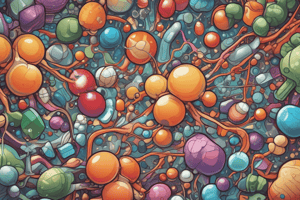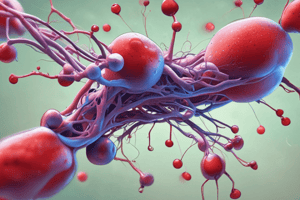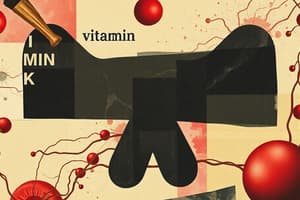Podcast
Questions and Answers
What is the main function of vitamin K as a coenzyme?
What is the main function of vitamin K as a coenzyme?
- Stimulating necrotic cell death
- Synthesizing blood coagulation factors (correct)
- Promoting inflammation in the body
- Inhibiting apoptosis in cells
What is the main role of zymogens in apoptosis?
What is the main role of zymogens in apoptosis?
- Inducing inflammation in the surrounding tissues
- Causing indiscriminate protein degradation
- Preventing cell death
- Mediating programmed cell death in a regulated manner (correct)
How are initiator caspases and executioner caspases different in apoptosis?
How are initiator caspases and executioner caspases different in apoptosis?
- Initiator caspases prevent cell death, while executioner caspases induce it
- Both types of caspases initiate cell death through indiscriminate protein degradation
- Initiator caspases cannot stop once initiated, whereas executioner caspases can (correct)
- Initiator caspases degrade proteins indiscriminately, while executioner caspases kill the cell in a regulated manner
In what way do zymogens contribute to developmental processes?
In what way do zymogens contribute to developmental processes?
What is the purpose of the pancreas secreting zymogens?
What is the purpose of the pancreas secreting zymogens?
What is the main purpose of proteolytic cleavage on zymogens?
What is the main purpose of proteolytic cleavage on zymogens?
How does accidental activation of zymogens occur?
How does accidental activation of zymogens occur?
What is the consequence of proteolytic cleavage on zymogens in terms of enzyme regulation?
What is the consequence of proteolytic cleavage on zymogens in terms of enzyme regulation?
What is the primary function of zymogens in the context of dietary protein digestion?
What is the primary function of zymogens in the context of dietary protein digestion?
Which of the following enzymes is NOT synthesized as a zymogen in the pancreas or stomach?
Which of the following enzymes is NOT synthesized as a zymogen in the pancreas or stomach?
How does the activation of pepsinogen to pepsin occur in the gastric lumen?
How does the activation of pepsinogen to pepsin occur in the gastric lumen?
What is the key purpose of synthesizing digestive enzymes as zymogens in the stomach and pancreas?
What is the key purpose of synthesizing digestive enzymes as zymogens in the stomach and pancreas?
What type of enzymes change shape upon binding an effector?
What type of enzymes change shape upon binding an effector?
Which type of enzyme regulation is characterized by irreversible activation cascades?
Which type of enzyme regulation is characterized by irreversible activation cascades?
What is the main function of zymogens in enzyme regulation?
What is the main function of zymogens in enzyme regulation?
Which regulatory mechanism involves changing gene expression to regulate enzyme synthesis or degradation?
Which regulatory mechanism involves changing gene expression to regulate enzyme synthesis or degradation?
In enzyme regulation, what type of enzymes bind noncovalently at a site other than the active site?
In enzyme regulation, what type of enzymes bind noncovalently at a site other than the active site?
Which of the following is NOT a small non-protein molecule acting as a cofactor?
Which of the following is NOT a small non-protein molecule acting as a cofactor?
What is the physiological relevance of zymogens?
What is the physiological relevance of zymogens?
Which of the following is a metal cofactor?
Which of the following is a metal cofactor?
What is the function of coenzymes in enzyme regulation?
What is the function of coenzymes in enzyme regulation?
What is the role of prosthetic groups in enzymes?
What is the role of prosthetic groups in enzymes?
Which statement best describes the function of coenzymes in enzyme activity?
Which statement best describes the function of coenzymes in enzyme activity?
How do zymogens contribute to enzyme regulation in the body?
How do zymogens contribute to enzyme regulation in the body?
Which vitamin plays a crucial role as a coenzyme in enzyme function?
Which vitamin plays a crucial role as a coenzyme in enzyme function?
In what way do coenzymes differ from prosthetic groups in enzyme activity?
In what way do coenzymes differ from prosthetic groups in enzyme activity?
What is the classical example of a heterotropic effector in enzyme regulation?
What is the classical example of a heterotropic effector in enzyme regulation?
Which type of allosteric protein is hemoglobin considered?
Which type of allosteric protein is hemoglobin considered?
What is the main role of phosphorylation in enzyme activity?
What is the main role of phosphorylation in enzyme activity?
Which type of effectors can influence the affinity of enzymes for their substrates?
Which type of effectors can influence the affinity of enzymes for their substrates?
What type of enzyme regulation involves altering the maximal catalytic velocity of enzymes?
What type of enzyme regulation involves altering the maximal catalytic velocity of enzymes?
Which group of effectors includes the presence of the substrate molecule enhancing enzyme properties at other substrate-binding sites?
Which group of effectors includes the presence of the substrate molecule enhancing enzyme properties at other substrate-binding sites?
What is a common reversible covalent modification involving enzymes?
What is a common reversible covalent modification involving enzymes?
What does feedback inhibition typically refer to in enzyme regulation?
What does feedback inhibition typically refer to in enzyme regulation?
What is the primary function of positive homotropic effectors in enzyme regulation?
What is the primary function of positive homotropic effectors in enzyme regulation?
What differentiates homotropic effectors from heterotropic effectors in enzyme regulation?
What differentiates homotropic effectors from heterotropic effectors in enzyme regulation?
Study Notes
Vitamin K and Enzyme Function
- Vitamin K serves as a crucial coenzyme in the synthesis of certain proteins required for blood coagulation and bone metabolism.
Zymogens and Apoptosis
- Zymogens play a significant role in apoptosis by being inactive precursors that, once activated, can carry out proteolytic functions leading to programmed cell death.
Initiator vs. Executioner Caspases
- Initiator caspases trigger the apoptotic process and activate executioner caspases, which are responsible for the actual cell dismantling.
Zymogens in Development
- Zymogens contribute to developmental processes by regulating proteolytic enzymes, ensuring that they are activated at appropriate stages for development.
Pancreatic Zymogen Secretion
- The pancreas secretes zymogens to prevent digestive enzymes from prematurely activating and damaging the pancreatic tissue.
Proteolytic Cleavage of Zymogens
- Proteolytic cleavage converts zymogens into their active forms, enabling them to perform their enzymatic functions and regulate cellular processes.
Accidental Activation of Zymogens
- Accidental activation can happen due to improper environmental conditions or interactions with other molecules, leading to unintended digestion.
Consequence of Proteolytic Cleavage
- Proteolytic cleavage is essential for enzyme regulation; it transforms zymogens into active enzymes and controls the timing of enzymatic activity.
Zymogens in Protein Digestion
- Zymogens facilitate dietary protein digestion by ensuring that proteases are activated only in the gastrointestinal tract, preventing self-digestion.
Non-Zymogen Enzyme
- Certain enzymes, such as amylase, are synthesized in their active forms rather than as zymogens in the pancreas or stomach.
Activation of Pepsinogen
- Pepsinogen is activated to pepsin in the acidic environment of the gastric lumen, allowing protein digestion to commence.
Purpose of Digestive Zymogens
- Zymogens are synthesized in an inactive form to prevent the damage of digestive tissues and ensure regulation of enzymatic activity.
Enzyme Binding and Effectors
- Enzymes that change shape upon binding an effector are typically allosteric enzymes, altering their activity based on ligand binding.
Irreversible Activation
- Enzyme regulation characterized by irreversible activation cascades often refers to proteolytic cleavage of zymogens.
Zymogens and Enzyme Regulation
- The primary function of zymogens in enzyme regulation is to ensure that enzymes are activated at the right time and location, maintaining cellular integrity.
Gene Expression Mechanism
- Regulatory mechanisms involving changes in gene expression allow for the synthesis or degradation of enzymes as needed by the cell.
Non-Covalent Binders
- Enzymes that bind non-covalently at sites other than the active site are typically regulated by allosteric effectors.
Small Non-Protein Cofactors
- Molecules such as vitamins and metal ions are crucial cofactors, but specific compounds like large peptides do not qualify as small non-protein molecules.
Metal Cofactor Examples
- Zinc and magnesium are examples of metal cofactors that assist in enzyme function.
Coenzymes in Regulation
- Coenzymes activate enzymes by assisting in the transfer of small molecules necessary for enzyme activity.
Prosthetic Groups Role
- Prosthetic groups are tightly bound to enzymes and play a key role in maintaining enzyme structure and function during catalysis.
Coenzyme Functionality
- Coenzymes are essential for increasing enzyme activity, often serving as transient carriers of specific atoms or functional groups.
Zymogens and Regulation
- Zymogens contribute to enzyme regulation by ensuring that proteases are activated only when required, preventing unwanted proteolytic activity.
Coenzyme Vitamins
- Vitamins like B12 and folate are crucial coenzymes that significantly influence various biochemical pathways.
Coenzymes vs. Prosthetic Groups
- Unlike prosthetic groups that are permanently attached, coenzymes associate and dissociate from enzymes during catalytic cycles.
Heterotropic Effectors
- A classical example of a heterotropic effector is ATP, which influences enzyme activity by binding regulation at a site distinct from the active site.
Hemoglobin's Allosteric Properties
- Hemoglobin acts as a heterotropic allosteric protein, altering its oxygen-binding affinity in response to physiological conditions.
Phosphorylation Role
- Phosphorylation modulates enzyme activity, often enhancing or inhibiting function through the addition of phosphate groups.
Effector Type Influence
- Both positive and negative effectors can influence enzyme affinity for substrates, impacting the rate of enzymatic reactions.
Maximal Catalytic Velocity
- Enzyme regulation that alters the maximal catalytic velocity involves changes in enzyme concentration or structural modifications.
Positive Substrate Effectors
- Positive homotropic effectors enhance the properties of an enzyme at other substrate-binding sites by stabilizing the active form.
Feedback Inhibition
- Feedback inhibition refers to the process where the end product of a metabolic pathway inhibits an enzyme involved in its production to prevent overaccumulation.
Positive Homotropic Effectors
- Positive homotropic effectors increase the likelihood of substrate binding, enhancing the enzyme's catalytic effectiveness.
Homotropic vs. Heterotropic Effectors
- Homotropic effectors are substrates that bind to the active site, while heterotropic effectors bind to different sites, influencing enzyme activity.
Studying That Suits You
Use AI to generate personalized quizzes and flashcards to suit your learning preferences.
Related Documents
Description
Test your knowledge on Vitamin K as a coenzyme in blood coagulation, the mechanism of action of Warfarin in depleting active Vitamin K, and the role of zymogens in apoptosis. Explore the connections between these biochemical processes.




